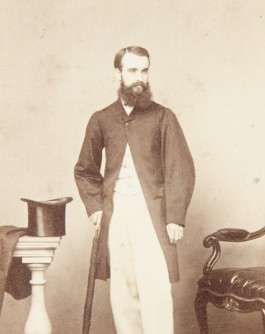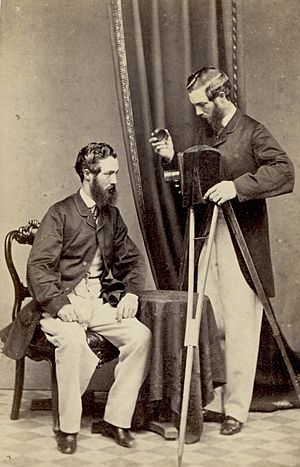Frederick Frith facts for kids
Frederick Frith (born 1819, died 1871) was a talented English artist. He was both a painter and a photographer. He started his career in England. Later, he moved to Australia, living in Hobart and Melbourne.
Contents
Early Life and Family
Frederick Frith was born in the United Kingdom in 1819. His family was known for being artists, including painters and silhouettists (people who make silhouette portraits). His parents were John and Letitia Frith. He had a younger brother named Henry Albert and a younger sister named Letitia. In 1858, Frederick married Emma Golding.
Starting His Art Career
Frederick studied and worked as a painter in many places. These included London, Brighton, Ireland, and Scotland. In 1853, he was asked to show his paintings. One famous painting was called Death of a Stag.
In 1855, Frederick moved to Melbourne, Australia. He first worked there as a painter. Later that same year, he moved to Hobart. He showed his art in Melbourne in 1854. Most of his works were watercolour and oil paintings.
Working with John Sharp
While showing his art in 1855, Frederick met John Mathieson Sharp. They decided to work together. They opened a studio that Sharp had just bought. They called their studio the Chromatype Gallery.
The word "Chroma" comes from Greek and means "colour." This name was important because they used a special method. They would paint over photographs printed on salted paper. They used oil, watercolour, or pastel paints. Only a few of their "Chromatype" artworks still exist today. They show how they added colour to these paper photographs. This method was similar to another process called a Photo-crayotype.
Creating Panoramas
Sharp and Frith made the first paper panorama in Australia. A panorama is a very wide picture, like a super-wide photo. Their panorama showed a view of Hobart. It was made of five parts and was almost a metre long! They used a special photography method called the collodion or wet-plate process.
They advertised copies of this panorama for sale in a newspaper in January 1856. This panorama was seen as a very important step. It helped start the business of selling photo albums and prints to people in the community.
A Legal Case
In 1855, Frederick Frith had a problem with a merchant (a person who sells things) in Hobart Town named Samuel Moses. Frederick had painted portraits of Samuel and his family. But Samuel refused to pay him. He said the paintings cost too much and that Frith didn't put enough effort into them.
Even though Frederick's paintings might not have been his very best, he still won the case. The court decided that Samuel Moses had to pay Frederick for the paintings and for the trouble he caused.
Working with His Brother Henry
In 1856, Frederick's partnership with John Sharp ended. Sharp continued to make chromatypes and stereographs (3D photos) in his studio. Frederick started his own studio. He began to focus more on photography and less on painting. He made large photos of Hobart and the areas around it.
A year later, in 1857, Frederick's younger brother, Henry, joined his business. Henry often traveled for the studio to take photos. In 1858, Frederick showed two more panoramas. Both were taken in Hobart, one at the Domain and another near St Paul's Church.
In 1858, the Frith brothers opened a second studio in Launceston. They sold individual prints and albums. They advertised bound albums with 3-6 views for five guineas. A single print cost one guinea. Their sister, Letitia Davidson, continued to run the Hobart studio, which was called 'Frith & Co.'.
Frederick's artworks were very popular. However, they were sometimes quite expensive. This led to more court cases about prices. He also showed his famous Death of a Stag painting again at the Hobart Town Art Treasures Exhibition. This earned him more money and showed it was still one of his most well-known pieces.
The Double Portrait
Around 1866, Frederick Frith created a special "double portrait." He made it to show off his amazing technical skills. This kind of photo makes it look like the same person is in two places in one picture. He likely used a special screen or plate holder to block part of the camera's view for each shot.
Frederick's camera didn't have a fast shutter like modern cameras. The "wet plate process" he used needed the camera's lens to be open for several seconds.
Later Life and Legacy
Frederick Frith passed away in 1871. He is remembered for his unique way of taking photos that seemed very hard for other photographers to do. Even though he didn't live a very long life, he left behind many amazing pictures that people will remember for years.
Throughout his career, Frederick seemed more interested in painting. This was especially true when he worked with John Sharp. Sharp was known as the photographer, and Frith was known as the painter. By combining photography and painting, many of his portrait photos looked like beautiful watercolour paintings.



